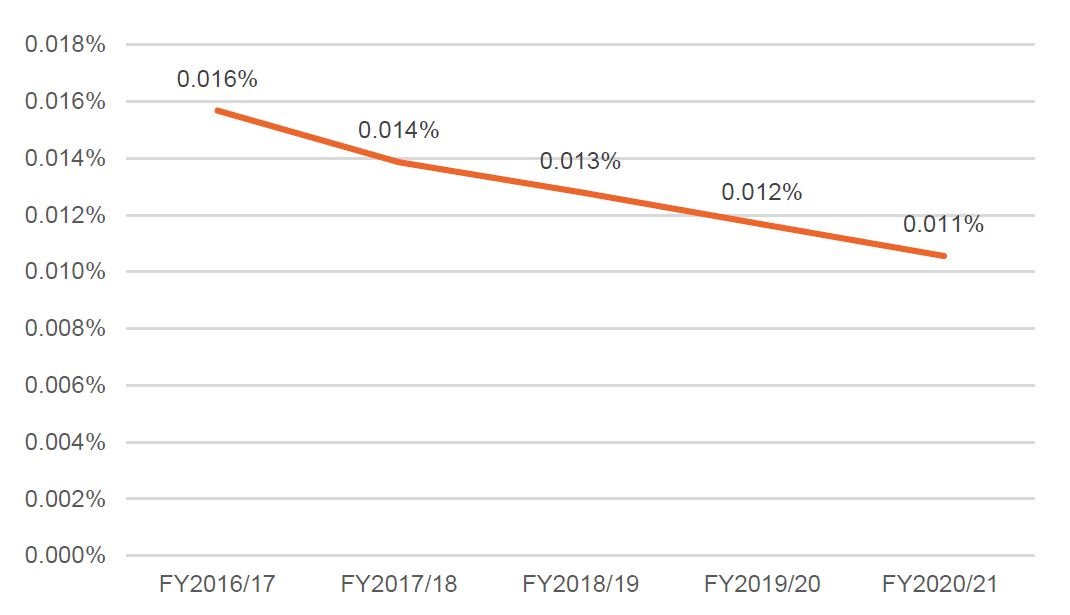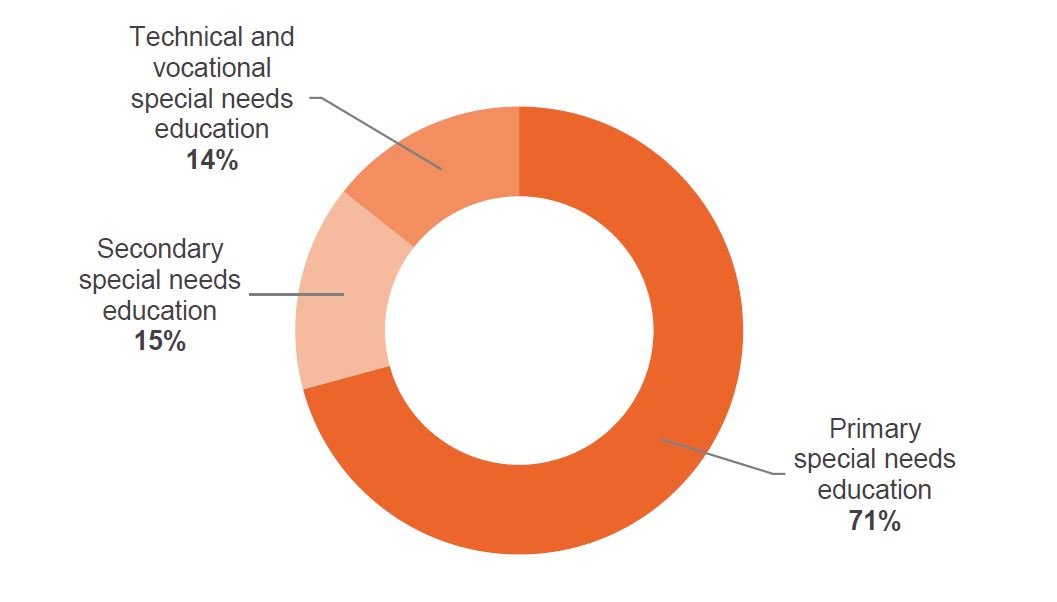Government funding to support disability inclusion in Kenya
This report looks at how government funding is supporting disability inclusion in Kenya by analysing budget allocations over the last five financial years.
DownloadsExecutive summary
This report presents research that was undertaken as part of Development Initiatives’ work on data to support disability inclusion . It provides analysis of government budget allocations to disability inclusion programmes in Kenya over the period of financial year 2016/17 (FY2016/17) to financial year 2020/21 (FY2020/21). The analysis focuses on disability-relevant ministries, departments and agencies at the national level, including those led by the State Department for Social Protection, the Office of the President, the State Department for Early Learning and Basic Education, and the State Department for Vocational and Technical Training. Due to limitations in the available data, the analysis looks primarily at the education and social protection sectors.
This report has been funded with UK aid from the UK government, and was developed with the support of the Inclusive Futures consortium. The opinions expressed are those of the author(s) and do not necessarily reflect the views or policies of the UK government or other members of the Inclusive Futures consortium .
Key findings
The Kenyan government has made important progress in establishing specific social protection, economic empowerment and education programmes that directly support persons with disabilities. However, funding to some programmes has either reduced or remained over the recent fiscal years. This may limit the scope of the programmes that directly benefit persons with disabilities.
The summary of key findings below is organised by relevant government budget holders.
State Department for Social Protection
- Between FY2016/17 and FY2020/21, the State Department for Social Protection earmarked KES 9 billion for programmes that promote inclusion and empowerment of persons with disabilities. These funds went to the National Development Fund for Persons with Disabilities (NDFPWD), the Cash Transfer for Persons with Severe Disabilities (PWSD-CT) scheme, and vocational rehabilitation and social development services.
- The PWSD-CT accounted for two thirds of the funds that the State Department for Social Protection earmarked for inclusion and empowerment of persons with disabilities between FY2016/17 and FY2020/21.
- Annual budget allocations to the PWSD-CT and NDFPWD remained constant at KES 1.2 billion and KES 259 million respectively between FY2016/17 and FY2019/20.
- Funds earmarked for vocational rehabilitation of persons with disabilities amounted to KES 1 billion over the five fiscal years, with annual allocations reducing by 32.2% in FY2019/20 and by 9.1% in FY2020/21.
- The reduction in funding to vocational rehabilitation may increase the risk that persons with disabilities are left behind in access to employment during and after the Covid-19 pandemic.
Office of the President
- The Office of the President increased budget allocations to the National Fund for the Disabled of Kenya (NFDK) fivefold from KES 100 million in FY2016/17 to KES 550 million in the first supplementary budget of FY2019/20. [1]
- However, allocations to the NFDK reduced significantly, by 72.7%, in the second supplementary budget of FY2019/20, which was developed at the onset of the Covid-19 pandemic in Kenya. [2]
- Allocations to the NFDK increased by a third from the second supplementary budget figure to KES 200 million in FY2020/21.
State Department for Early Learning and Basic Education
- The State Department for Early Learning and Basic Education earmarked KES 4.7 billion for primary special needs education and KES 1 billion for secondary special needs education between FY2016/17 and FY2020/21.
- Annual budget allocations for primary special needs education increased by 3% in both FY2017/18 and FY2018/19 but reduced by 6.5% and 7.7% in FY2019/20 and FY2020/21 respectively, while annual allocations for secondary special needs education remained constant at KES 200 million over the five fiscal years.
- The funding gap for primary special needs education increased nearly threefold to KES 637 million in FY2020/21, while the funding gap for secondary special needs education increased from KES 100 million in FY2018/19 to KES 306 million in FY2020/21. [3]
- Children with disabilities are likely to be left behind and excluded from access to education if special needs education, particularly efforts to include persons with disabilities into the mainstream education system, are underfunded.
State Department for Vocational and Technical Training
- The State Department for Vocational and Technical Training earmarked KES 961 million for special needs education at tertiary level between FY2016/17 and FY2020/21.
- In FY2019/20, annual budget allocations for special needs education at tertiary level reduced by a quarter and remained constant in 2020/21. This is was a result of the fact that, unlike the previous fiscal years, there was no allocation for capital expenditure in FY2019/20 and FY2020/21.
- With no budget allocation for capital expenditure, access to equipment and expansion of infrastructure in vocational and technical institutions may be difficult, slowing efforts to equip persons with disabilities with the skills required for employment.
Key challenges
- Key programmes, such as special needs education at primary and secondary level, are not being adequately funded.
- Funds such as the National Fund for the Disabled of Kenya and the National Development Fund for Persons with Disabilities have an overlap in mandates and support similar programmes.
- The lack of data on programme outcomes hinders analysis of how budget allocations contribute to disability inclusion.
- There are significant inconsistencies in the available budget data. The data is also not adequately disaggregated by age, gender and disability.
Introduction
National budget allocations to support disability inclusion
As a signatory to the UN Convention on the Rights of Persons with Disabilities (CRPD) and the Global Disability Charter for Change, the Kenyan government has committed to the economic, social and political inclusion of persons with disabilities – who account for between 2.2% and 15% of Kenya’s population. [4]
Alongside provisions in policy, legalisation and in the mandates of key institutions, [5] the national budget is an important indicator of government commitment to disability inclusion. For example, by allocating resources to programmes that enhance inclusion and remove barriers to employment, the government can support persons with disabilities to exercise their right to decent work.
Disability inclusive development
Disability inclusion ensures all people have the opportunity to participate in society to the best of their abilities and desires. This requires deliberate efforts to ensure persons with disabilities can meaningfully participate in decisions that may impact their lives, including in economic, social and political processes such as government budgeting.
Persons with disabilities, and the organisations that represent them, have an important role to play in ensuring the national budget adequately resources and reflects government commitment to disability inclusion. By tracking budgetary allocations and engaging in budgetary decisions, organisations of persons with disabilities can help ensure that the government is adequately supporting socioeconomic integration and protection against discrimination.
This will be particularly important in the implementation of the FY2020/21 national budget and the development of the FY2021/22 budget to ensure that allocations for disability inclusion are not adversely affected by the Covid-19 pandemic. Despite the expected reduction in government spending due to lower revenue collection, [6] the government will need to allocate sufficient funding to the pandemic response in a way that actively takes into account the additional needs of persons with disabilities.
Analysing funding for disability inclusion
Tracking the allocation of budgets for disability inclusion is, however, a complex undertaking. At present, there is no standardised approach for tracking either ‘disability-relevant’ budgets (that is, those targeted towards supporting persons with disabilities but not leading towards their economic or societal inclusion) or ‘disability-inclusive’ budgets (that is, those that directly promote economic and societal inclusion of persons with disabilities). Furthermore, a lack of data on the estimated cost of enabling disability inclusion in line with policy commitments, makes it difficult to assess whether allocated resources are sufficient.
Approaches that have been used include: the analysis of budgets for disability mainstreaming and CRPD compliance; [7] analysis of budget allocations to disability-focused ministries, departments and agencies (MDAs) [8] and programmes in various MDAs that support persons with disabilities; [9] analysis of budgets allocated to disability services and facilities; [10] and analysis of disability expenditure as a proportion of GDP. [11]
Limitations in the availability of publicly accessible budgetary data, and the lack of detailed disaggregation, for example by gender and disability, within the available data have constrained the widespread adoption of these approaches. There are also significant challenges faced in identifying whether budgets are specifically targeted towards the inclusion of persons with disabilities or whether the budgets are just targeted at persons with disabilities but do not promote their inclusion. Furthermore, a lack of information on programme outcomes makes it difficult to determine whether expenditure is actually contributing to the inclusion of persons with disabilities.
Building on the methodology used by Centre for Budget and Governance Accountability, our analysis looks at budgetary allocations to disability inclusion programmes under Kenya’s disability-relevant MDAs. [12] However, our analysis focuses primarily on the education and social protection sectors as limitations in the available data prevent budgetary analysis of all sectors.
Our approach, which is further detailed in the ‘Methodology’ section at the end of the report, involved using a keyword search technique to identify budgetary allocations to programmes that support persons with disabilities directly. This was followed by a manual examination of programme documents to determine whether the budgets are targeted towards inclusion or not.
The analysis presented in this report covers the period FY2016/17 to FY2020/21.
Investments in disability inclusion
Investments in social protection and economic empowerment programmes
The State Department for Social Protection (SDSP) implements several social protection and economic empowerment programmes that directly benefit persons with disabilities. These include cash transfers, vocational rehabilitation and grants for socioeconomic empowerment. In addition, the Office of the President provides funding to the National Fund for the Disabled of Kenya to facilitate implementation of economic empowerment programmes.
Figure 1: The State Department for Social Protection’s (SDSP’s) budget for disability inclusion, FY2016/17 to FY2020/21
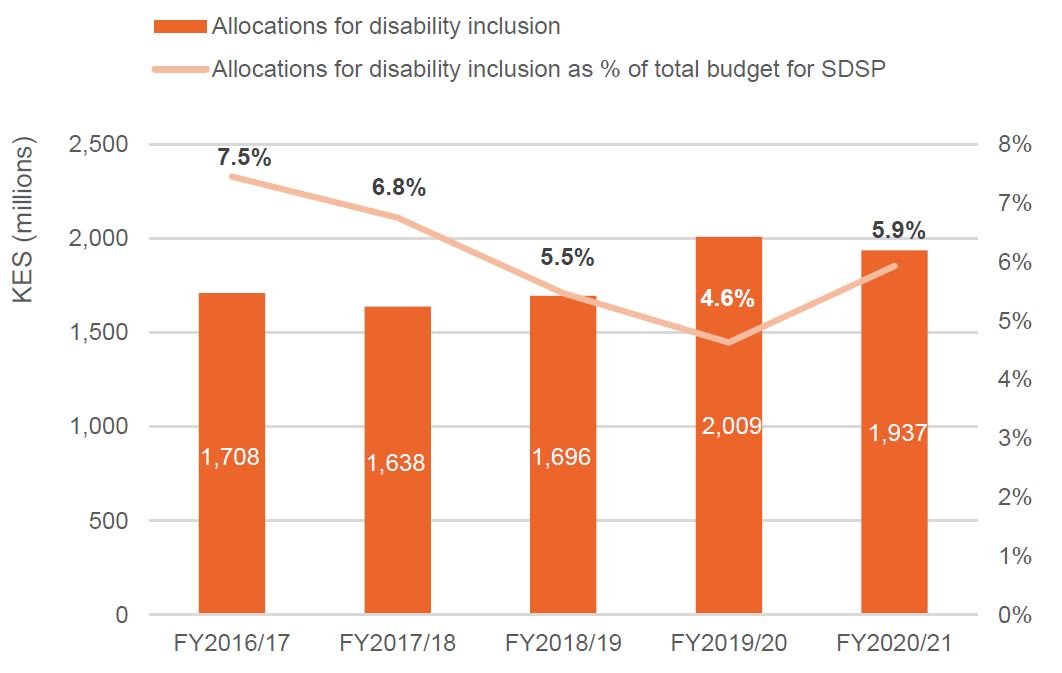
| FY2016/17 | FY2017/18 | FY2018/19 | FY2019/20 | FY2020/21 | |
|---|---|---|---|---|---|
|
Allocations
for disability inclusion |
1,708,291,130 | 1,637,533,510 | 1,695,643,297 | 2,008,814,850 | 1,937,485,685 |
|
Allocations
for disability inclusion as % of total budget for SDSP |
7.5% | 6.8% | 5.5% | 4.6% | 5.9% |
Source: Development Initiatives based on national government budget documents for FY2016/17 to FY2020/21.
Note: SDSP = State Department for Social Protection.
The SDSP earmarked KES 9 billion for programmes that promote inclusion and empowerment of persons with disabilities between FY2016/17 and FY2020/21. The allocations went to the Social Welfare and Vocational Rehabilitation subprogramme which has three interventions that target persons with disabilities: the National Development Fund for Persons with Disabilities (NDFPWD), vocational rehabilitation, and social development services. The allocations also went to the Social Assistance to Vulnerable Groups subprogramme, particularly the Cash Transfer for Persons with Severe Disabilities (PWSD-CT). The budget for disability inclusion as a percentage of the SDSP’s total budget reduced from 7.5% in FY2016/17 to 4.6% in FY2019/20 but increased slightly in FY2020/21 (Figure 1).
Figure 2: The State Department for Social Protection’s budget for disability inclusion as a percentage of GDP, FY2016/17 to FY2019/20
As a percentage of GDP, the SDSP’s annual budget for disability inclusion reduced slightly from 0.02% in FY2019/20 to 0.017% in FY2020/21 (Figure 2). The SDSP’s budget for disability inclusion accounted for 0.1% of the total budget for national government ministries, departments and agencies in FY2019/20 and FY2020/21. [13]
Figure 3: Allocations made by the State Department for Social Protection, FY2016/17 to FY2020/21
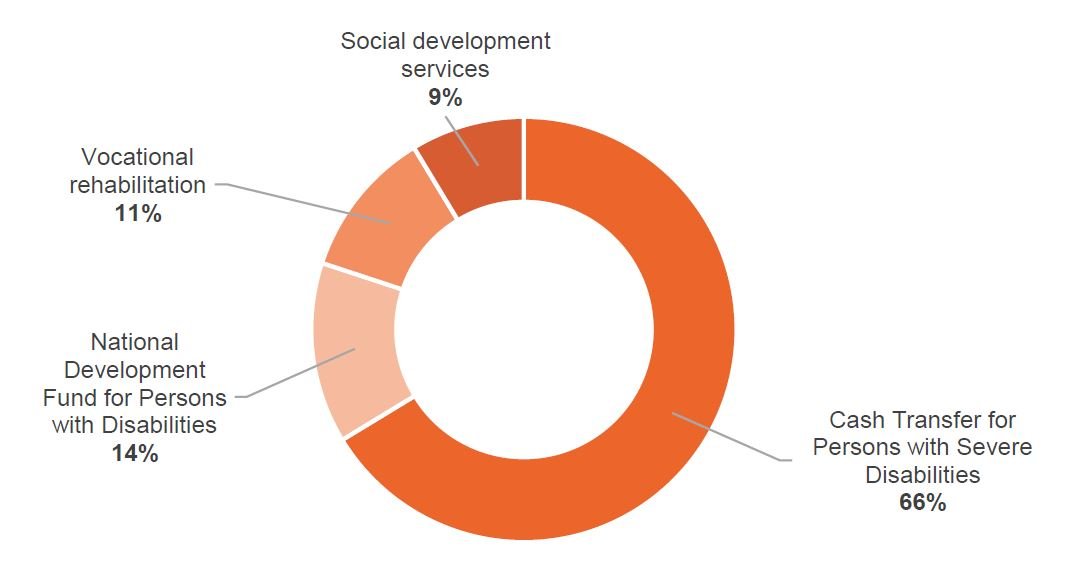
| Volume (KES) | |
|---|---|
|
Cash Transfer
for Persons with Severe Disabilities |
5,960,000,000 |
|
National
Development Fund for Persons with Disabilities |
1,236,000,000 |
|
Vocational
rehabilitation |
1,013,658,310 |
|
Social
development services |
778,110,162 |
| Total | 8,987,768,472 |
Source: Development Initiatives based on national government budget documents for FY2016/17 to FY2019/20.
The main beneficiaries of the allocations made by the SDSP were the PWSD-CT and the NDFPWD, which accounted for 66% and 14% of the SPSP’s budget for disability inclusion respectively over the five fiscal years (Figure 3).
Figure 4: Allocations to the National Development Fund for Persons with Disabilities (NDFPWD) made by the State Department for Social Protection (SDSP), FY2016/17 to FY2019/20
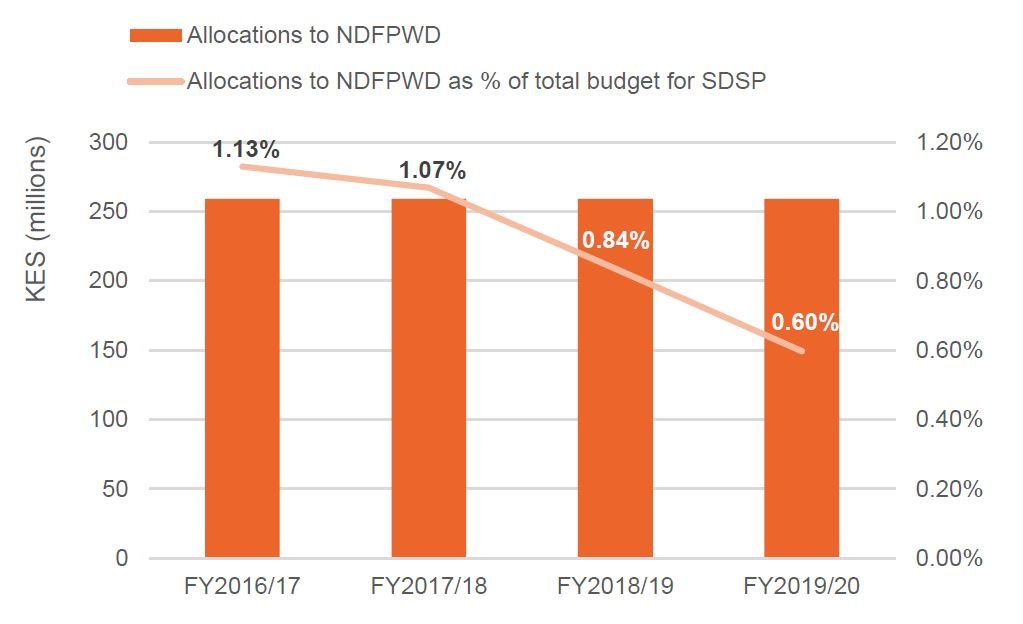
| FY2016/17 | FY2017/18 | FY2018/19 | FY2019/20 | |
|---|---|---|---|---|
|
Allocations
to NDFPWD |
259,000,000 | 259,000,000 | 259,000,000 | 259,000,000 |
|
Allocations
to NDFPWD as % of total budget for SDSP |
1.13% | 1.07% | 0.84% | 0.60% |
Source: Development Initiatives based on national government budget documents for FY2016/17 to FY2019/20.
Notes: SDSP = State Department for Social Protection; NDFPWD = National Development Fund for Persons with Disabilities.
The NDFPWD was established under the Persons with Disabilities Act as a permanent fund managed by the National Council for Persons with Disabilities. The NDFPWD draws its funding mainly from annual disbursements from the national government and provides support to persons with disabilities in all counties in Kenya.
Allocations to the NDFPWD remained constant at KES 259 million between FY2016/17 and FY2019/20 (Figure 4); [14] however, as a proportion of the SDSP’s total budget, the percentage going to the NDFPWD reduced by nearly half between FY2016/17 and FY2020/21.
The NDFPWD uses this funding to provide education scholarships, to facilitate economic empowerment through grants that enable persons with disabilities to engage in self-employment, and to provide grants to organisations of persons with disabilities to conduct advocacy. The funds are also used to provide infrastructure and equipment support to learning institutions as well as assistive devices and services to persons with disabilities and albinism. In FY2018/19, for example, disbursement from the NDFPWD went mainly to infrastructure and equipment support, and education assistance, which accounted for 37.6% and 37.3% of disbursements respectively.
Limited availability of actual expenditure data makes it difficult to conduct a trend analysis of disbursements from the NDFPWD. For instance, currently, only data for FY2018/19 has been published in full, while the data for FY2019/20 covers only three of the six programmes that are supported by the NDFPWD.
Figure 5: Allocations to the Cash Transfer for Persons with Severe Disabilities (PWSD-CT) made by the State Department for Social Protection (SDSP), FY2016/17 to FY2020/21
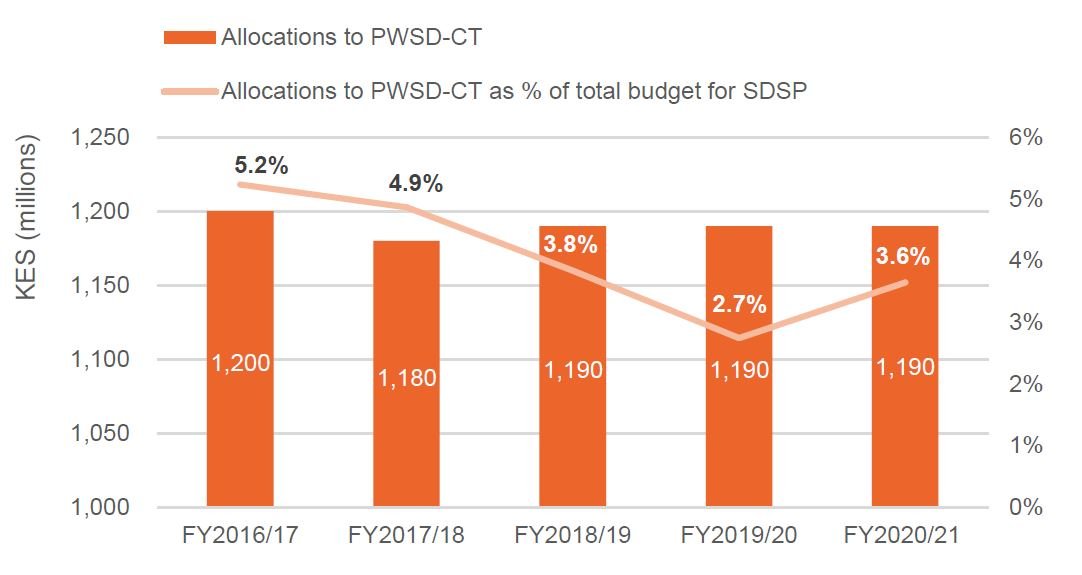
| FY2016/17 | FY2017/18 | FY2018/19 | FY2019/20 | FY2020/21 | |
|---|---|---|---|---|---|
|
Allocations
to PWSD-CT |
1,200,000,000 | 1,180,000,000 | 1,190,000,000 | 1,190,000,000 | 1,190,000,000 |
|
Allocations
to PWSD-CT as % of total budget for SDSP |
5.2% | 4.9% | 3.8% | 2.7% | 3.6% |
Source: Development Initiatives based on national government budget documents for FY2016/17 to FY2019/20.
Notes: PWSD-CT = Cash Transfer for Persons with Severe Disabilities; SDSP = State Department for Social Protection.
The PWSD-CT is one of the three cash transfer programmes implemented under the National Safety Net Programme. The objective of the PWSD-CT is to provide income support to improve the lives of persons with severe disabilities, while strengthening the capacity of caregivers and improving household livelihood opportunities. PWDS-CT operates in all counties in Kenya, with an enrolment of 51,890 households. [15] The PWSD-CT targets households rather than individuals, which may limit the choice and control over the use of the cash transfers by the persons with disabilities themselves.
To be eligible for the PWSD-CT, a household must be in extreme poverty; have a person with profound disability who requires permanent care, including feeding, washing and protection from danger; and not be enrolled in any other cash transfer programme. [16] The amount paid to beneficiaries is KES 2,000 per household per month, delivered every two months.
Allocations to the PWSD-CT made by the SDSP amounted to KES 6 billion between FY2016/17 and FY2020/21. As a proportion of the SDSP’s total budget, the percentage going to the PWSD-CT reduced from 5.2% in FY2016/17 to 2.7% in FY2019/20, gaining back some of the loss in FY2020/21 (Figure 5).
Figure 6: Allocations to the Cash Transfer for Persons with Severe Disabilities as a percentage of GDP, FY2016/17 to FY2020/21
The annual budget allocations to the PWSD-CT as a percentage of GDP reduced consistently between FY2016/17 and FY2020/21 (Figure 6).
In FY2020/21, the demand for financial assistance may increase due to the health, social and economic impacts of the Covid-19 pandemic. However, with no increase in allocations to the PWSD-CT, it is not clear how an escalation in needs will be addressed.
Figure 7: Allocations for vocational rehabilitation of persons with disabilities made by the State Department for Social Protection (SDSP), FY2016/17 to FY2020/21
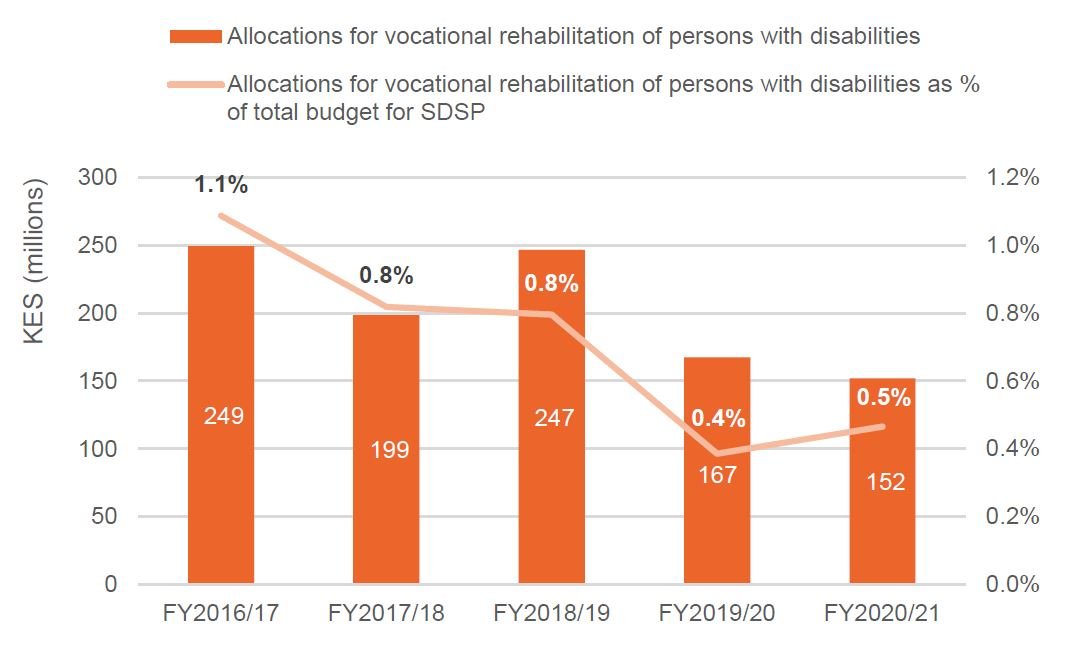
| FY2016/17 | FY2017/18 | FY2018/19 | FY2019/20 | FY2020/21 | |
|---|---|---|---|---|---|
|
Allocations
for vocational rehabilitation of persons with disabilities |
249,291,130 | 198,533,510 | 246,643,297 | 167,235,780 | 151,954,593 |
|
Allocations
for vocational rehabilitation of persons with disabilities as % of total budget for SDSP |
1.1% | 0.8% | 0.8% | 0.4% | 0.5% |
Source: Development Initiatives based on national government budget documents for FY2016/17 to FY2020/21.
Note: SDSP = State Department for Social Protection.
The SDSP facilitates vocational rehabilitation of persons with disabilities through its Social Welfare and Vocational Rehabilitation subprogramme. The aim of vocational rehabilitation is to promote the employment of persons with disabilities by equipping them with skills through training.
The national government allocated a total of KES 1 billion for vocational rehabilitation between FY2016/17 and FY2020/21. However, allocations reduced by 32.2% in FY2019/20 and by 9.1% in FY2020/21. Allocations to vocational rehabilitation as a percentage of the total budget for the SDSP reduced between FY2016/17 and FY2019/20, but increased marginally in FY2020/21 (Figure 7). In addition to vocational training for persons with disabilities, the funds have been spent on improvements to vocational rehabilitation centres through measures such as renovations, purchase of equipment and development of infrastructure.
In FY2019/20, the budget for the Social Welfare and Vocational Rehabilitation subprogramme included an allocation of KES 393 million for social development services. The funds were earmarked for provision of scholarships to persons with disabilities in all levels of education and provision of sunscreen lotion to persons with albinism. Allocations to social development services in FY2020/21 reduced by 1.8% to KES 386 million.
The Covid-19 pandemic has brought to the fore the need to ensure that workers have the technological skills to work from home and collaborate online with others. As the level of unemployment increases due to the impact of the pandemic, [17] having technological skills will be increasingly important for accessing employment opportunities. Accordingly, vocational rehabilitation is expected to play a critical role in supporting persons with disabilities to access employment opportunities during and after the pandemic. However, the reduction in funding to vocational rehabilitation may increase the risk that persons with disabilities are left behind in access to employment.
As the Covid-19 pandemic continues to affect livelihoods, persons with disabilities may face difficulties in paying school fees for their children and persons with albinism may not be able to afford sunscreen lotion. Accordingly, in FY2020/21 the reduction in funding to social development services may exacerbate inequalities in access to education, and negatively affect the welfare of persons with albinism who are living in poverty.
Figure 8: Allocations to the National Fund for the Disabled of Kenya (NFDK) made by the Office of the President, FY2016/17 to FY2020/21
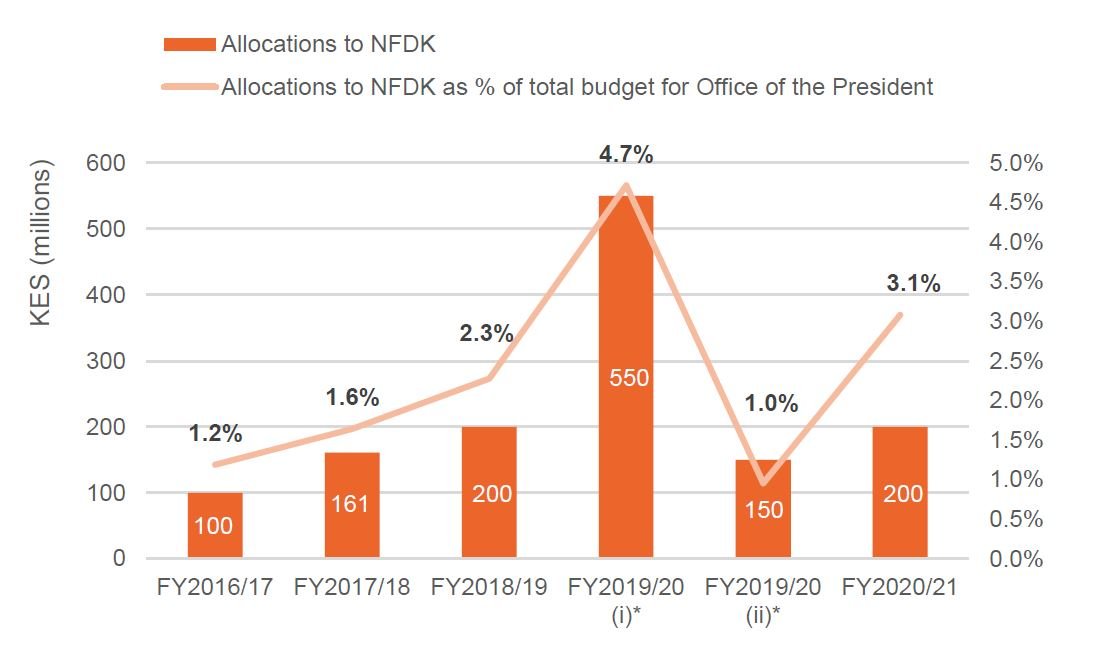
| FY2016/17 | FY2017/18 | FY2018/19 | FY2019/20 (i)* | FY2019/20 (ii)* | FY2020/21 | |
|---|---|---|---|---|---|---|
|
Allocations
to NFDK |
100,000,000 | 160,900,000 | 200,000,000 | 550,000,000 | 150,000,000 | 200,000,000 |
|
Allocations
to NFDK as % of total budget for Office of the President |
1.2% | 1.6% | 2.3% | 4.7% | 1.0% | 3.1% |
Source: Development Initiatives based on national government budget documents for FY2016/17 to FY2020/21.
Notes: NFDK = National Fund for the Disabled of Kenya. *The budget for FY2019/20 was revised in December 2019 and in April 2020. FY2019/20(i) refers to the first revision (first supplementary budget) and FY2019/20(ii) refers to the second revision (second supplementary budget).
The National Fund for the Disabled of Kenya (NFDK) [18] was established as a trusteeship under the Trustees (Perpetual Succession) Act Chapter 164. [19] The NFDK has an overarching goal of promoting the empowerment of persons with disabilities through donations to individuals and institutions. The NFDK draws its funding from annual grants from the national government, rental income and donations. The Office of the President allocates funds to the NFDK through its Management of Cabinet Affairs subprogramme.
In the first supplementary budget of FY2019/20, [20] allocations to the NFDK more than doubled to KES 550 million compared with the FY2018/19 allocations. This increase was aimed at ensuring improved availability of resources to fund socioeconomic empowerment programmes that benefit persons with disabilities. However, following the confirmation of the first Covid-19 case in Kenya in March 2020, the national government budget was revised in April 2020, leading to a reduction in allocations to the NFDK of 72.7% – from KES 550 million in the first supplementary budget of FY2019/20 to KES 150 million in the second supplementary budget (Figure 8).
In FY2020/21, allocations to the NFDK increased by a third from the second supplementary budget of FY2019/20, to KES 200 million, which is equivalent to the allocation in FY2018/19. However, the Covid-19 pandemic may negatively affect the NFDK’s rental income. The increase in allocations in FY2020/21 is expected to ensure improved availability of resources to assist persons with disabilities through rehabilitation support and economic empowerment programmes.
Additionally, in June 2020, the Parliamentary Budget and Appropriations Committee recommended an increase in allocations to the Office of the President (Cabinet Affairs subprogramme) of KES 721 million. This allocation was subsequently included in the Budget Statement and earmarked for the purchase of a building for persons with disabilities. However, it is not clear from the available budget information how the building will be used to support inclusion and empowerment of persons with disabilities.
The lack of publicly available data to evaluate the performance of the NFDK, including the adequacy of the resources allocated to it to enhance inclusion and empowerment of persons with disabilities, is of concern. Analysis of the performance of the fund is critical for ensuring accountability.
Investments in education programmes that support persons with disabilities
The State Department for Early Learning and Basic Education facilitates access to special needs education at primary and secondary levels, whereas the State Department for Vocational and Technical Training is responsible for special needs education at tertiary level. The aim of special needs education is to ensure all Kenyans have access to education regardless of their special needs or disabilities.
Figure 9: Total allocations for special needs education, FY2016/17 to FY2020/21
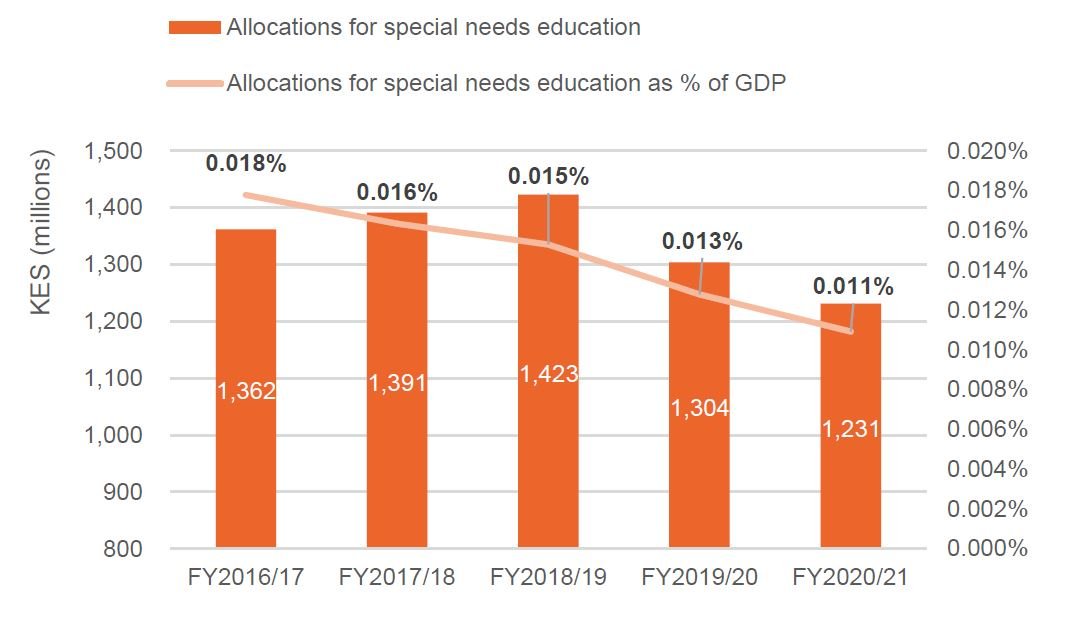
| FY2016/17 | FY2017/18 | FY2018/19 | FY2019/20 | FY2020/21 | |
|---|---|---|---|---|---|
|
Allocations
for special needs education |
1,361,651,052 | 1,391,251,052 | 1,423,236,416 | 1,303,727,727 | 1,231,110,683 |
|
Allocations
for special needs education as % of GDP |
0.018% | 0.016% | 0.015% | 0.013% | 0.011% |
Source: Development Initiatives based on national government budget documents for FY2016/17 to FY2020/21.
Note: This figure shows the total allocations for special needs education made by State Department for Early Learning and Basic Education and the State Department for Vocational and Technical Training.
The national government allocated a total of KES 6.7 billion to facilitate the implementation of education programmes that target persons with disabilities between FY2016/17 and FY2020/21. While budget allocations for special needs education increased by 2% in both FY2017/18 and FY2018/19, they reduced by 8% and 6% in FY2019/20 and FY2020/21 respectively. Allocations for special needs education as a percentage of GDP has been reducing over time (Figure 9).
Figure 10: Share of primary, secondary, and technical and vocational special needs education in the total budget for special needs education, FY2016/17 to FY2020/21
The bulk of the budget allocations (71%), went to primary special needs education, which accounted for just under three quarters of the total special needs education budget for the period FY2016/17 to FY2020/21 (Figure 10).
Figure 11: Allocations for primary special needs education made by the State Department for Early Learning and Basic Education, FY2016/17 to FY2020/21
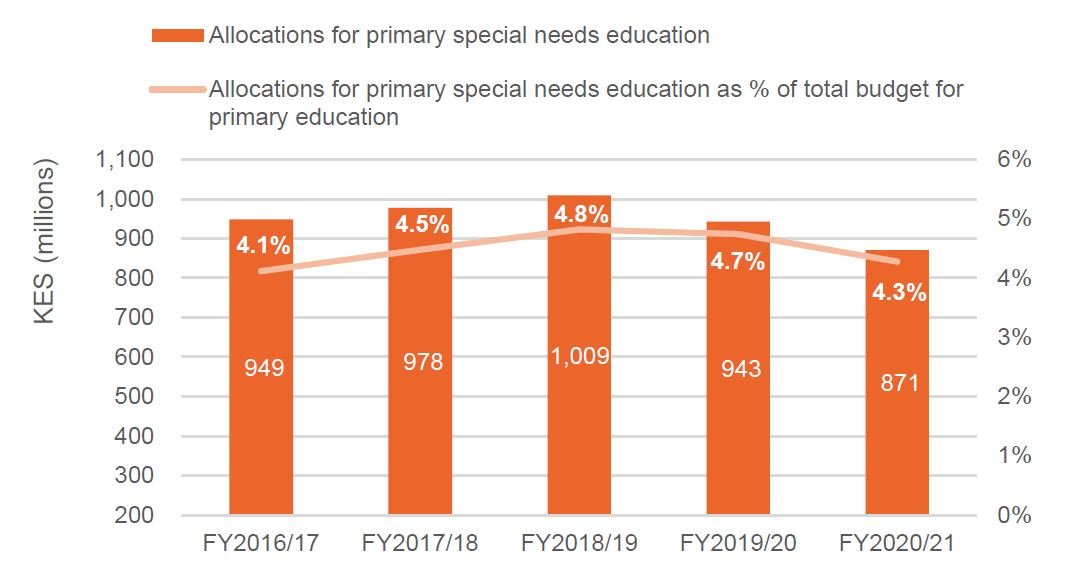
| FY2016/17 | FY2017/18 | FY2018/19 | FY2019/20 | FY2020/21 | |
|---|---|---|---|---|---|
|
Allocations
for primary special needs education |
948,500,000 | 978,100,000 | 1,009,089,332 | 943,276,675 | 870,659,631 |
|
Allocations
for primary special needs education as % of total budget for primary education |
4.1% | 4.5% | 4.8% | 4.7% | 4.3% |
Source: Development Initiatives based on national government budget documents for FY2016/17 to FY2020/21.
Kenya has 23,286 public primary schools of which 3,057 (13.1%) provide special needs education. [21] The 3,057 public special needs primary schools consist of 2,718 non-boarding integrated schools and 339 boarding special primary schools, which had a total enrolment of 100,827 and 39,629 students respectively in 2019. [22]
A total of KES 4.7 billion was earmarked for special needs education at primary level between FY2016/17 and FY2020/21 (Figure 11). Funding to primary special needs education increased by 3% in both FY2017/18 and FY2018/19. However, funding reduced by 6.5% and 7.7% in FY2019/20 and FY2020/21 respectively due to a reduction in the budget allocation for the construction of the National Psycho-Education Assessment Centre and a cut in the budget for Education Assessment and Resource Centres (EARC). EARCs play a key role in access to education through the assessment of children with disabilities and their placement in education services. Access to the services provided by EARCs may be negatively affected by the significant reduction of their allocation from KES 71.5 million in FY2018/19 to KES 18.1 million in FY2020/21.
The bulk of the allocation went to special needs education primary schools (integrated and special schools) and the Kenya Institute of Special Education (KISE), which accounted for 33.5% and 28.3% of the primary special needs education budget respectively between FY2018/19 and FY2020/21. The funds allocated to KISE facilitates training teachers of students with special needs, conducting research on special needs education and development of learning materials. While special primary schools promote access to education, they lead to segregation of students with disabilities. Accordingly, budget allocations to such schools may not be compliant with the Convention on the Rights of Persons with Disabilities, which requires governments to provide education to children with disabilities on an equal basis with other children and to provide education within an inclusive system.
Currently, budget documents lack details of how the funds allocated for special needs education is distributed between integrated primary schools and special primary schools. Such information is critical for tracking the progress in enhancing investments to integrated primary schools that promote inclusive education.
The funding gap for primary special needs education reduced by 31.4% from KES 312 million in FY2018/19 to KES 215 million in FY2019/20. [23] However, the funding gap increased nearly threefold to KES 637 million in FY2020/21. Children with disabilities are likely to be left behind and excluded from access to education if special needs education, particularly efforts to include persons with disabilities into the mainstream education system, are underfunded. This may lead to poor educational outcomes that may limit the ability of children with disabilities to access decent jobs in adulthood.
Figure 12: Allocations for secondary special needs education made by the State Department for Early Learning and Basic Education, FY2016/17 to FY2020/21
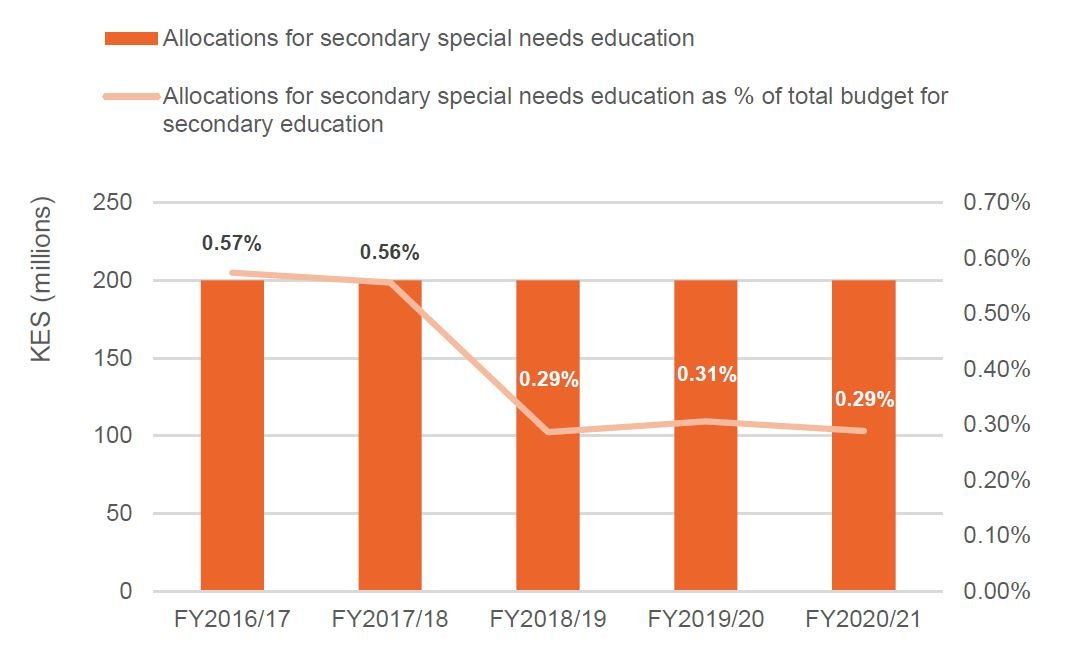
| FY2016/17 | FY2017/18 | FY2018/19 | FY2019/20 | FY2020/21 | |
|---|---|---|---|---|---|
|
Allocations
for secondary special needs education |
200,000,000 | 200,000,000 | 200,000,000 | 200,000,000 | 200,000,000 |
|
Allocations
for secondary special needs education as % of total budget for secondary education |
0.57% | 0.56% | 0.29% | 0.31% | 0.29% |
Source: Development Initiatives based on national government budget documents for FY2016/17 to FY2020/21.
Kenya has 8,933 public secondary schools, but only 147 (1.6%) of these provide special needs education. The 147 secondary special needs schools consist of 37 special institutions and 110 integrated institutions, with a combined enrolment of 14,153 students. [24]
The annual allocation to secondary special needs education remained constant at KES 200 million over the last five fiscal years (Figure 12). However, the share of special needs education in the total budget for secondary education reduced from 0.57% in FY2016/17 to 0.29% in 2020/21.The funds allocated to secondary special needs education cover costs such as tuition fees, boarding expenses, renovation of infrastructure and purchase of equipment. [25] As with primary education, while special secondary schools play an important role in access to education, they perpetuate segregation of children with disabilities. Accordingly, budget allocations to such schools may also not be compliant with the Convention on the Rights of Persons with Disabilities.
Secondary special needs education is facing a funding gap that has increased from KES 100 million in FY2018/19 to KES 306 million in FY2020/21. [26] Accordingly, additional resources have to be found and channelled to interventions that are aimed at enhancing access to inclusive secondary education, such as the expansion of integrated secondary schools.
Figure 13: Allocations for special needs technical and vocational education made by State Department for Vocational and Technical Training (SDVTT), FY2016/17 to FY2020/21
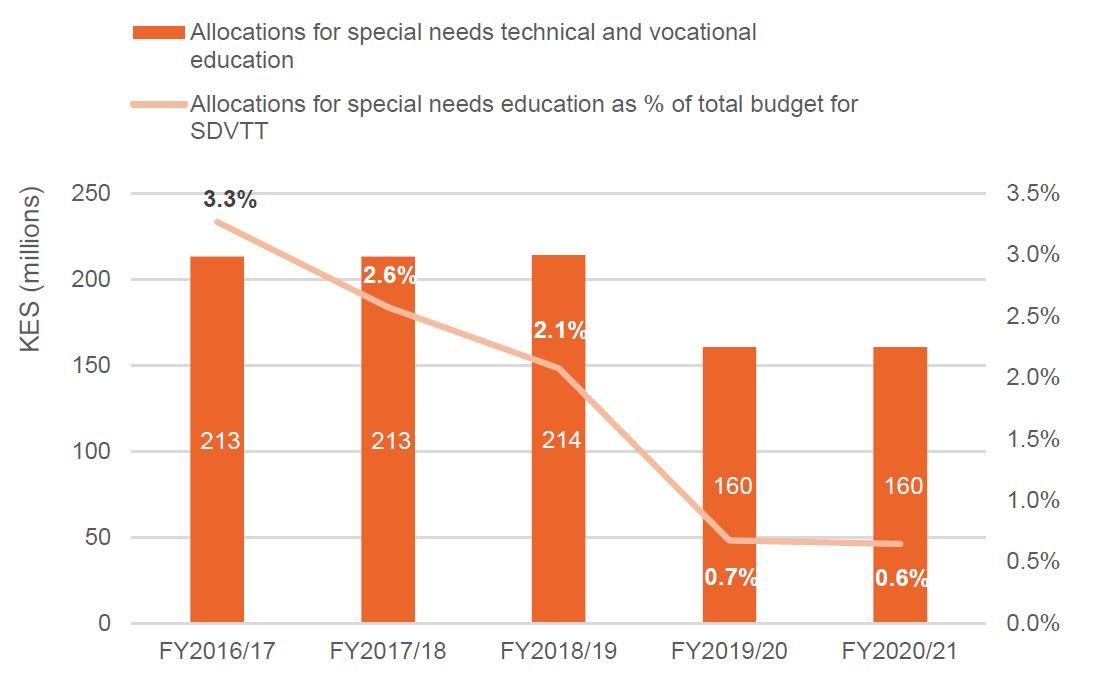
| FY2016/17 | FY2017/18 | FY2018/19 | FY2019/20 | FY2020/21 | |
|---|---|---|---|---|---|
|
Allocations
for special needs technical and vocational education |
213,151,052 | 213,151,052 | 214,147,084 | 160,451,052 | 160,451,052 |
|
Allocations
for special needs education as % of total budget for SDVTT |
3.3% | 2.6% | 2.1% | 0.7% | 0.6% |
Source: Development Initiatives based on national government budget documents for FY2016/17 to FY2020/21.
Note: SDVTT = State Department for Vocational and Technical Training.
Allocations for special needs technical and vocational education over the five fiscal years amounted to KES 961 million. Budget allocations reduced by a quarter in FY2019/20 and remained constant in FY2020/21 (Figure 13). This is a result of the fact that, unlike the previous fiscal years, there was no allocation for capital expenditure in FY2019/20 and FY2020/21.
The funds allocated for special needs technical and vocational education went to four tertiary institutions that provide technical and vocational training programmes that target persons with disabilities. These include Karen Technical Training Institute for the Deaf, Machakos Technical Institute for the Blind, Sikri Technical Training Institute and Nyangoma Technical Training Institute. These institutes were established to equip learners with visual and hearing impairments with the skills and knowledge needed for employment. The number of students enrolled in the four institutions stood at 1,757 in FY2018/19. [27]
As discussed earlier, vocational education and technical training is expected to play a critical role in the response to the Covid-19 pandemic by equipping persons with disabilities with skills to access employment. However, with no budget allocation for capital expenditure, access to equipment and expansion of infrastructure in vocational and technical institutions may be difficult, slowing efforts to train persons with disabilities. To improve the quality of education, the government set a target of training 100 instructors/technical trainers in both FY2016/17 and FY2017/18, and 50 instructors in FY2018/19, to provide training to persons with disabilities in tertiary learning institutions. However, the training was not provided in all the three fiscal years due to budget constraints. [28]
Conclusions
The allocation of resources within Kenya’s national budget towards disability inclusion programmes is an indicator of the government’s commitment to inclusion of persons with disabilities. This analysis shows that the Kenyan government has made important progress in establishing specific social protection, economic empowerment and education programmes that directly support persons with disabilities.
However, funding to key programmes such as primary special needs education and vocational rehabilitation has reduced in recent fiscal years. This may limit the scope of these programmes, with negative implications for the welfare of persons with disabilities.
Key challenges identified as part of this analysis were:
- Key programmes, such as special needs education at primary and secondary level, are not adequately funded. The continued increase in funding gaps is likely to negatively affect efforts to ensure inclusive education.
- Funds such as the National Fund for the Disabled of Kenya and the National Development Fund for Persons with Disabilities have an overlap in mandates and support similar programmes. This may negatively affect the efficiency in administration of the funds that are earmarked for social and economic empowerment of persons with disabilities.
- The lack of data of programme outcome hinders analysis of how budget allocations contribute to disability inclusion. Some organisations that receive funds from the government do not publish publicly accessible comprehensive information on how the funds are used and the outcomes achieved by the funded programmes. This slows efforts to ensure accountability through public scrutiny.
- There are significant inconsistencies in the available budget data. The data is also not adequately disaggregated by age, gender and disability. This prevents effective tracking of budget allocations to programmes that promote disability inclusion in all sectors.
Methodology
The methodological approach used for this analysis was developed by Development Initiatives and refined based on valuable contributions and insights from the Center for Inclusive Policy . The methodology is presented here so that it can be used by organisations of persons with disabilities in their budget tracking and advocacy. It can also be adapted for scrutinising disability investments at the county level.
Methodological approach
Step 1: Identifying disability inclusion budget lines
- A list of keywords and phrases was developed, based on a review of the literature, including budget and programme/project documents to identify budget items/activities that are related to disability inclusion. The list of keywords is provided at the end of this section.
- Keywords were applied to the national programme-based budgets for the period FY2016/17 to FY2020/21 to identify budget lines for programmes and subprogrammes where supporting persons with disabilities is included as a key objective or output.
- The objectives of the identified subprogrammes and programmes were also reviewed to determine how they support inclusion of persons with disabilities.
- Activities were considered for analysis only if persons with disabilities were clearly identified in the budget or project/programme documents as one of the targeted beneficiary groups and there are mechanisms to ensure they benefit from the budgets.
Step 2: Extracting data for the identified budget lines/items
- Programme-based budgets provide data that is disaggregated up to subprogramme level only. Therefore, to extract data for specific allocations for disability inclusion which do not appear on the programme-based budget, the respective delivery unit codes were obtained from the programme-based budget and used to trace the allocations in the line item budget documents. This involved using the codes to conduct a search in both the development and recurrent line item budget documents. Line item budget provides the details of planned spending, with a focus on the inputs e.g. office rent, electricity bills etc. It also breaks down the planned spending under various sub-programmes. For instance, it shows how much of the funds allocated to the National Safety Net Programme that goes to the Cash Transfer for Persons with Severe Disabilities and other cash transfers that target vulnerable households. Programme-based budget, on the other hand, links the planned spending to specific outputs and objectives. However, it provides data that is disaggregated at programme and sub-programme level only. So, for instance, it is not possible to identify from the programme-based budget how much has been allocated to the Cash Transfer for Persons with Severe Disabilities or National Development Fund for Persons with Disabilities as these are aggregated under various sub-programmes.
- Apart from the line item budget and programme-based budget documents, reference was made to the Budget Highlights and Budget Statement to check for the consistency of the budget data, as well as to access details/data that is not available in the line item and programme-based budget documents.
Notes on inflation and calculation of the funding gap
We have used nominal values for this analysis. In the period 2016 and 2019, the average annual inflation rate was 6% which is within the national government’s target range of 5 ± 2.5%.
The funding gap is the difference between the estimated amount of resources required to implement a programme in a particular fiscal year and the actual funds allocated for implementation of the programme. The resource requirement data was obtained from the various sectors’ medium-term expenditure framework reports for various fiscal years, whereas the actual resource allocation data was obtained from the budget documents. The funding gap, therefore, is an indication of the extent to which a programme is underfunded.
Limitation of the scope of the analysis
Due to limitations in the available data, this analysis has mainly focused on education, social protection and economic empowerment programmes that promote disability inclusion. While there are programmes that promote disability inclusion and empowerment of persons with disabilities in other sectors such as health, analysing the allocation to such programmes is constrained by a lack of disaggregated data. For instance, there is no publicly available data on the proportion of the allocations to the Health Insurance Subsidy Programme that goes to persons with disabilities. With improved availability of disaggregated data, more comprehensive analysis of disability inclusion budget allocations in all sectors would be possible.
Keywords
Persons with disabilities, people with disabilities, disability, disabled, disabilities, PWD, social welfare, special need, blind, deaf, braille, cash transfer, rehabilitation, vocation, fund, inclusion, special interest groups (SIGs), assistance, social assistance, assistive device, scholarship, sign language, marginalised, impair, visually impaired, affirmative, affirmative action, vulnerable, discrimination, equality, empowerment, grants.
Acronyms
| CRPD | Convention on the Rights of Persons with Disabilities |
|---|---|
| EARC | Education Assessment and Resource Centres |
| FY | Financial year |
| GDP | Gross domestic product |
| KISE | Kenya Institute of Special Education |
| MDAs | Ministries, departments and agencies |
| NDFPWD | National Development Fund for Persons with Disabilities |
| NFDK | National Fund for the Disabled of Kenya |
| PWSD-CT | Cash Transfer for Persons with Severe Disabilities |
| SDSP | State Department for Social Protection |
Downloads
Notes
-
1
The budget for FY2019/20 was developed in June 2019. It was later revised twice: first in December 2019 and then again in April 2020. The first supplementary budget refers to the budget revised in December 2019 and the second supplementary budget refers to the budget revised in April 2020.Return to source text
-
2
The budget for FY2019/20 was developed in June 2019. It was later revised twice: first in December 2019 and then again in April 2020. The first supplementary budget refers to the budget revised in December 2019 and the second supplementary budget refers to the budget revised in April 2020.Return to source text
-
3
Funding gap refers to the difference between the estimated amount of resources required to implement a programme in a given financial year and the actual funds allocated for implementation of the programme. See the methodology section for more details.Return to source text
-
4
The 2019 Kenya Census documented a disability prevalence rate of 2.2%. However global estimates by the World Health Organisation predict a higher prevalence rate of around 15%. Development Initiatives’ 2020 paper Status of disability in Kenya unpacks Kenya’s disability statistics. See: /publications/status-disability-kenya-statistics-2019-census/Return to source text
-
5
This commitment is backed by legislation such as the 2010 Constitution of Kenya and the 2003 Persons with Disability Act and implemented by key institutions such as the National Council for Persons with Disabilities, the State Department for Social Protection, the National Gender and Equality Commission, the State Department for Early Learning and Basic Education, the Kenya National Human Rights Commission, and county governments.Return to source text
Related content
Disability-inclusive ODA: Aid data on donors, channels, recipients
How much ODA goes to projects focused on the inclusion and empowerment of persons with disabilities? Read analysis of the scale and channels of aid.
Status of disability in Kenya: Statistics from the 2019 census
Accurate census figures can support inclusion of people with disabilities, but what do the figures tell us about disability in Kenya, and how accurate are they?
Data to support disability inclusion
Read more about our work to create and test innovative approaches to improve the long-term economic empowerment and inclusion of persons with disabilities in Kenya and Uganda.

